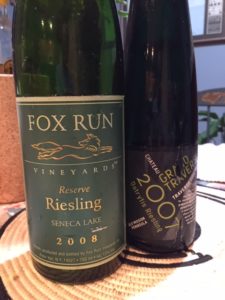For this early September Wine of the Week, I actually present two wines, both Rieslings, and both over a decade old.
The dry version is Fox Run’s Reserve Riesling 2008 (Seneca Lake, New York AVA). Winemaker Peter Bell only makes a reserve in great vintages for Riesling when the fruit can ripen slowly and fully, to make a classic Finger Lakes dry Riesling. The 2008 vintage was such a classic year.
Tasting Notes: *** Color: medium gold. Nose: petrol and mineral at first, but then ripe, fruity red apple and yellow peach. Palate: forward, juicy ripe apple and peach, matched with brilliant fresh acidity. Vibrant and youthful and a perfect balance of ripe fruit with firm acidity. Alcohol 13%, proving you can ripen Riesling to almost 24 Brix, ferment dry, and still have a perfectly balanced wine that can age. Worth waiting for but could also have been enjoyed young.
For the sweet version, it’s Chateau Grand Traverse Botrytis Riesling 2007, Old Mission Peninsula AVA, Michigan. These grapes were grown in vintage conditions that favored the spread of botrytis mold, which shrivels the grapes and concentrates the remaining sugar and acidity in the remaining juice as well as giving a distinct apricot flavor to the wine. These grapes were picked at 30 Brix (very high) but the wine was fermented to 13.5%, leaving 7.4% residual sugar.
Tasting Notes: *** Color: medium gold. Nose: vivid dried apricots. Palate: first, dried apricots, then ripe, juicy/bursting yellow peach, then, vivid balancing acidity, with a fresh finish. As with the Fox Run Reserve, the decision to ferment to 13.5% alcohol gave a balanced wine. This has intensity of fruit balanced with acidity, but the higher alcohol means a reasonable residual sugar level that you can match with a pear tart (as I did) or with a ripe cheese, and at 12 years of age, everything is in balance. Nice glycerol viscosity on the palate but acidity balances; resembles a Tokaij Aszu in texture.
As I have written before, older Rieslings from classic cool climate regions (northern Michigan and Finger Lakes both qualify), if well-cellared, will taste best in the first two years, or after 10 years, due to complex chemical reasons that have been documented but which I decline to elaborate on (biochemistry geeks: see “free vs. bound volatile terpenes”).
*** rating = Outstanding

